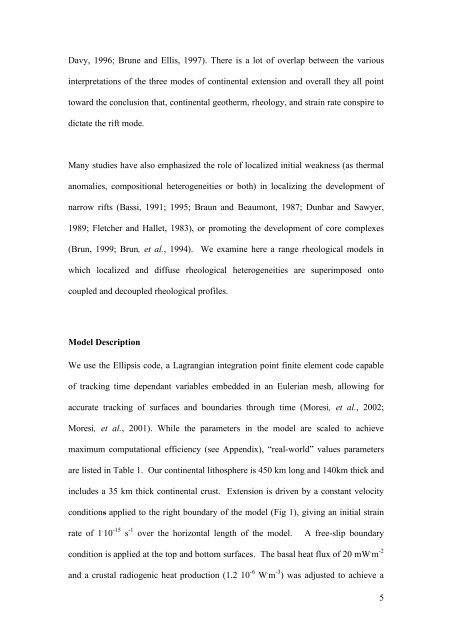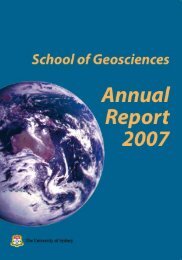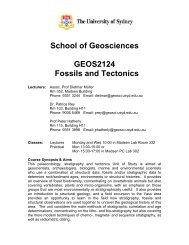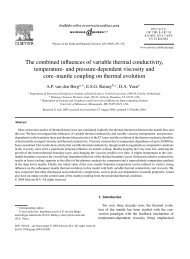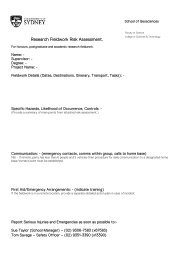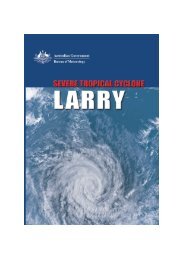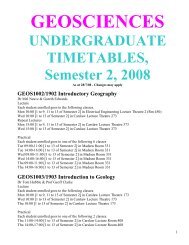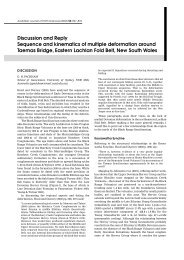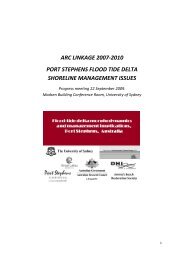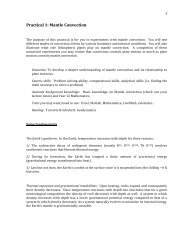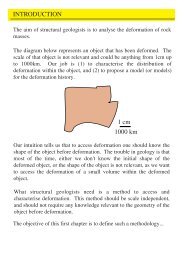Effects of Initial Weakness on Rift Architecture - School of Geosciences
Effects of Initial Weakness on Rift Architecture - School of Geosciences
Effects of Initial Weakness on Rift Architecture - School of Geosciences
You also want an ePaper? Increase the reach of your titles
YUMPU automatically turns print PDFs into web optimized ePapers that Google loves.
Davy, 1996; Brune and Ellis, 1997). There is a lot <str<strong>on</strong>g>of</str<strong>on</strong>g> overlap between the various<br />
interpretati<strong>on</strong>s <str<strong>on</strong>g>of</str<strong>on</strong>g> the three modes <str<strong>on</strong>g>of</str<strong>on</strong>g> c<strong>on</strong>tinental extensi<strong>on</strong> and overall they all point<br />
toward the c<strong>on</strong>clusi<strong>on</strong> that, c<strong>on</strong>tinental geotherm, rheology, and strain rate c<strong>on</strong>spire to<br />
dictate the rift mode.<br />
Many studies have also emphasized the role <str<strong>on</strong>g>of</str<strong>on</strong>g> localized initial weakness (as thermal<br />
anomalies, compositi<strong>on</strong>al heterogeneities or both) in localizing the development <str<strong>on</strong>g>of</str<strong>on</strong>g><br />
narrow rifts (Bassi, 1991; 1995; Braun and Beaum<strong>on</strong>t, 1987; Dunbar and Sawyer,<br />
1989; Fletcher and Hallet, 1983), or promoting the development <str<strong>on</strong>g>of</str<strong>on</strong>g> core complexes<br />
(Brun, 1999; Brun, et al., 1994). We examine here a range rheological models in<br />
which localized and diffuse rheological heterogeneities are superimposed <strong>on</strong>to<br />
coupled and decoupled rheological pr<str<strong>on</strong>g>of</str<strong>on</strong>g>iles.<br />
Model Descripti<strong>on</strong><br />
We use the Ellipsis code, a Lagrangian integrati<strong>on</strong> point finite element code capable<br />
<str<strong>on</strong>g>of</str<strong>on</strong>g> tracking time dependant variables embedded in an Eulerian mesh, allowing for<br />
accurate tracking <str<strong>on</strong>g>of</str<strong>on</strong>g> surfaces and boundaries through time (Moresi, et al., 2002;<br />
Moresi, et al., 2001). While the parameters in the model are scaled to achieve<br />
maximum computati<strong>on</strong>al efficiency (see Appendix), “real-world” values parameters<br />
are listed in Table 1. Our c<strong>on</strong>tinental lithosphere is 450 km l<strong>on</strong>g and 140km thick and<br />
includes a 35 km thick c<strong>on</strong>tinental crust. Extensi<strong>on</strong> is driven by a c<strong>on</strong>stant velocity<br />
c<strong>on</strong>diti<strong>on</strong>s applied to the right boundary <str<strong>on</strong>g>of</str<strong>on</strong>g> the model (Fig 1), giving an initial strain<br />
rate <str<strong>on</strong>g>of</str<strong>on</strong>g> 1 . 10 -15 s -1 over the horiz<strong>on</strong>tal length <str<strong>on</strong>g>of</str<strong>on</strong>g> the model.<br />
A free-slip boundary<br />
c<strong>on</strong>diti<strong>on</strong> is applied at the top and bottom surfaces. The basal heat flux <str<strong>on</strong>g>of</str<strong>on</strong>g> 20 mW . m -2<br />
and a crustal radiogenic heat producti<strong>on</strong> (1.2 10 -6 W . m -3 ) was adjusted to achieve a<br />
5


